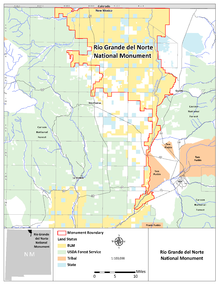Rio Grande del Norte National Monument
| Rio Grande del Norte National Monument | |
|---|---|
U.S. Bureau of Land Management | |
| Website | Rio Grande del Norte National Monument |

The Rio Grande del Norte National Monument is an approximately 242,555-acre (98,159 ha) area of public lands in
The monument includes two BLM recreation areas, a portion of the

Environment
The monument includes portions of the
History
The valley of the Rio Grande has been inhabited at least to the
Activities
Rafting and boating through the Rio Grande Gorge is a popular activity. Rapids vary between Class II and Class V. Rafting and boating trips are available from commercial outfitters. Mountain biking is permitted on designated trails and roads. Off-highway vehicles are permitted on designated roads. A number of paved highways cross the monument, including the Wild Rivers Backcountry Byway, New Mexico Highway 570, and U.S. Routes 64 and 285. Route 64 crosses the Rio Grande Gorge on the 660-foot (200 m) high Rio Grande Gorge Bridge. Fishing for brown and rainbow trout and northern pike is available on the Red River and the Rio Grande, subject to New Mexico regulations. Hunting is also permitted in the monument, subject to game regulations. There are five campgrounds located within the monument, one in the river gorge.[4]
Administration
The
Two BLM visitor centers serve the monument. The Wild Rivers Visitor Center is located in the Wild Rivers Recreation Area near Questa. The Rio Grande Gorge Visitor Center is near the Orilla Verde Recreation Area near Pilar. The monument is administered from the BLM's Taos field office.[4]
See also
References
- ^ National Archives.
- ^ Tom Sharpe (March 24, 2013). "Rio Grande del Norte National Monument may boost tourism". The Santa Fe New Mexican. Retrieved March 23, 2013.
- ^ John M. Broder (March 22, 2013). "Obama to Name New National Monuments" (blog "The Caucus"). The New York Times. Retrieved March 23, 2013.
- ^ a b c d "Rio Grande del Norte National Monument". Bureau of Land Management. Retrieved 26 March 2013.
- ^ National Archives.
